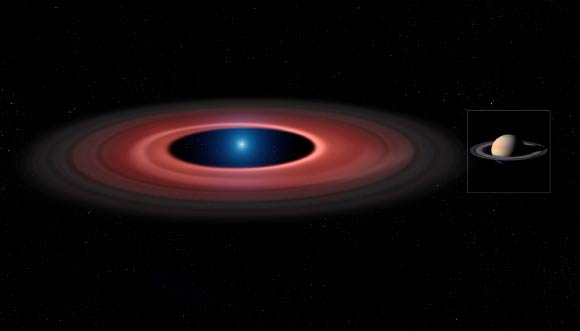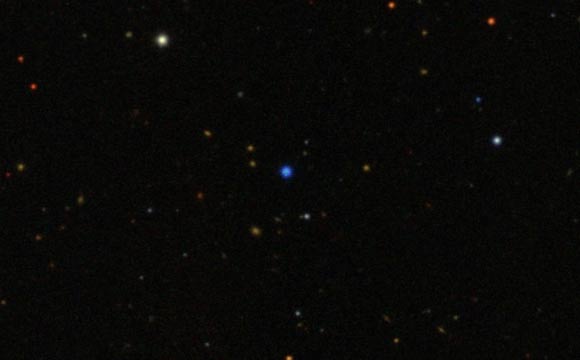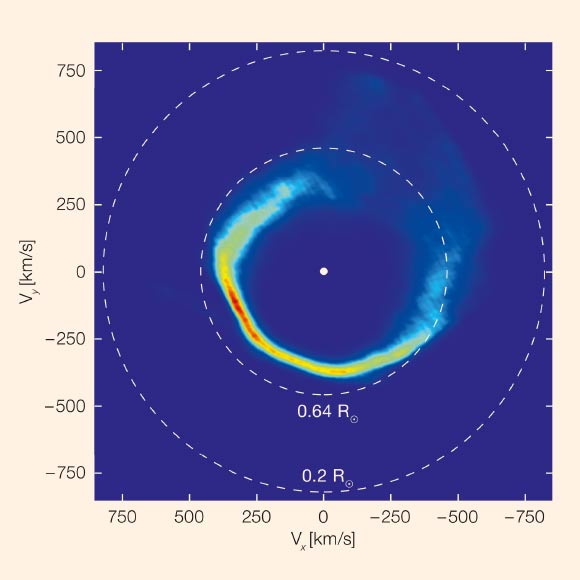The sight of a massive asteroid being ripped apart by a white dwarf called SDSS J122859.93+104032.9 (J1228+1040 for short) and forming a debris disk has been captured in an image by a multinational group of astronomers using ESO’s Very Large Telescope (VLT) at Paranal Observatory, Chile.

An artist’s impression of the debris disc around J1228+1040 (left) at the same scale as Saturn and its rings (right). While the star has about 7 times smaller diameter than Saturn, it has a mass 2,500 times greater. Image credit: Mark Garlick, www.markgarlick.com / University of Warwick / ESO / NASA / Cassini.
“We knew about debris disks around white dwarfs for over twenty years, but have only now been able to obtain the first image of one of these disks”, explained team leader Christopher Manser, of the University of Warwick, UK.
Manser and co-authors obtained detailed observations of the light coming from J1228+1040 and its surrounding material over an unprecedented period of 12 years between 2003 and 2015. This system, known also as WD 1226+110, lies approximately 450 light-years from our own Solar System.
“The image we get from the processed data shows us that these systems are truly disk-like, and reveals many structures that we cannot detect in a single snapshot,” Manser said.
To acquire the image of the system, the astronomers used a technique called Doppler tomography, which is very similar to Computed Tomography routinely used in hospitals. Both methods take scans from many different angles which are then combined in a computer into an image.

The white dwarf J1228+1040 (center). Image credit: SDSS / Centre de Données astronomiques de Strasbourg / SIMBAD.
“When we discovered this debris disk orbiting the white dwarf J1228+1040 back in 2006, we thought we saw some signs of an asymmetric shape,” said team member Prof. Boris Gänsicke, also of the University of Warwick.
“However, we could not have imagined the exquisite details that are now visible in this image constructed from twelve years of data – it was definitely worth the wait.”
The astronomers concluded that a massive asteroid had strayed dangerously close to the white dwarf and been ripped apart by the immense tidal forces it experienced to form the disk of material that is now visible.
The orbiting disk was formed in similar ways to the photogenic rings seen around planets closer to home, such as Saturn.

Motions of the material around the white dwarf J1228+1040. This plot is an unusual type of image, showing the velocities of the gas in the disc around the star, rather than its position. It was mapped out from ESO’s VLT observations over a period of twelve years and by applying a method called Doppler tomography. The dashed circles correspond to material in circular orbits at two different distances from the star. This appears inside out because material moves faster in close-in orbits. Image credit: University of Warwick / C. Manser / ESO.
According to the astronomers, remnants such as J1228+1040 can provide key clues to understanding the environments that exist as stars reach the ends of their lives. This can help scientists to understand the processes that occur in planetary systems and even forecast the fate of our Solar System when the Sun meets its demise in about 7 billion years.
The results will be published in the Monthly Notices of the Royal Astronomical Society, but have been published on arXiv.org ahead of time.
_____
C. Manser et al. 2015. Doppler-imaging of the planetary debris disc at the white dwarf SDSS J122859.93+104032.9. MNRAS, accepted for publication; arXiv: 1511.02230







